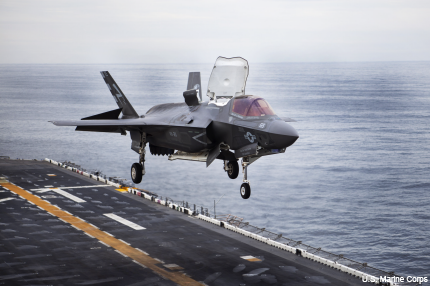Multitasking data link keeps Marines’ operational F-35s in touch
Northrop Grumman’s Multifunction Advanced Data Link gives pilots the equivalent of 27 avionics subsystems, the company says.

An F-35B executes a vertical landing.
In a breakthrough for the Defense Department’s troubled Joint Strike Fighter program—the most expensive weapons system ever—the Marine Corps announced last week that its variant of the F-35 Lightning II had achieved initial operational capability. One feature helping things work aboard the complex aircraft is
Northrop Grumman’s Multifunction Advanced Data Link (MADL) waveform, which lets pilots covertly communicate and coordinate operations, the company said in a release.
According to previous statements by the contractor, the MADL is a high-data-rate, directional communications link that allows coordinated tactics and engagement for significant operational advantages in high-threat environments for the F-35,the military’s fifth generation aircraft..
During the first few waves of tests aboard the F-35, the MADL, a key capability of the F-35’s integrated communications, navigation and identification (CNI) avionics, established links between two aircraft passing data back and forth to “form a simplified situational awareness picture on the cockpit displays.”
“During the flight tests, MADL functioned reliably with excellent range at multiples of required specifications while demonstrating ability to network fifth-generation fighters,” Mike Twyman, then vice president and general manager of the Defense Systems division for Northrop Grumman Information Systems, said at the time. “This success is a significant achievement for the F-35 program and enabling joint aerial concept of operations.”
Additional capabilities provided by Northrop’s CNI system include simultaneous operation of multiple critical functions, reducing size, weight and power demands as well as identification of friend and foe, acquisition of fly-to points and voice and data communication. Northrop also said its CNI “provides to F-35 pilots the equivalent capability of over 27 avionics subsystems.”
In its most recent announcement, Jeannie Hilger, Northrop’s vice president and general manager, communications division for its Information Systems, said that the CNI system, including the MADL,
“provides a core capability for fifth-to-fourth generation networked data sharing and unparalleled interoperability.”
The F-35, made by Lockheed Martin, is the core of the Joint Strike Fighter program. The aircraft is intended to replace the military’s F-16, A-10, F/A-18 and AV-8B fighters, and be used by the Air Force, Navy Marines and forces of 10 or more other countries. The Marine’s F-35B, which features short take-off and vertical landing capability, is one of three variants. The F-35A has conventional take-off and landing and the F-25C will be carrier-based. It’s the most complex weapons system ever developed, with 24 million lines of computer code in each aircraft, and the $400 billion program has been plagued by delays and cost overruns, some of them caused by software bugs.
Although declared operational, the first squadron to use the F-35 won’t be deployed until 2017, when it moves to Japan. And the F-35 overall still faces years of testing.




